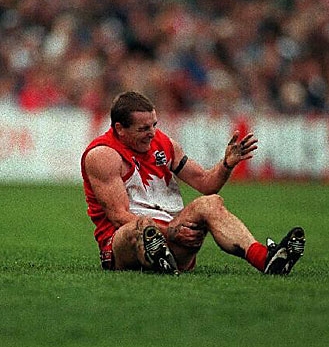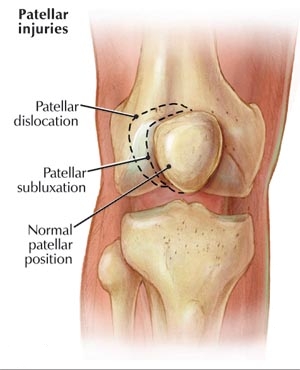 Patella Dislocation is a knee injury that can regularly occur in sports that involve twisting motions of the knee, and where the patella (knee cap) is dislodged laterally out of the patellofemoral groove at the front of the knee.
Patella Dislocation is a knee injury that can regularly occur in sports that involve twisting motions of the knee, and where the patella (knee cap) is dislodged laterally out of the patellofemoral groove at the front of the knee.
Its is an injury that is most common in younger athletes, between 16-20 years old, but can also occur randomly by impact in contact sports.
Perhaps the most watched patella dislocation injury in the AFL history, was when Sydney Swan footballer, Daryn Cresswell, dislocated his kneecap and was trying desperately to knock it back into place.
Patella Instability Pain
[toc]Patella Instability is also a condition that is not as common as some of the injuries that we have covered so far, but can either cause excruciating pain if dislodged, or restricting athlete discomfort if the patella is not tracking properly in the patellofemoral groove.
In this article of the SportStrap “How to Strap” series, I’d like to take a closer look at the injury itself, and how to strap for patella dislocation and instability.
How is the Patella Injured
There are varing degrees of Patella injuries from Patella Subluxation through to Patella Dislocation.

Patella Sublaxation is where the an unstable patella, or knee cap, does not track centrally in the groove at the end of the thigh bone as the knee bend, causing discomfort to the sides of the knee. This can be common in younger athletes, and can be hereditary.
Patella Dislocation is where the knee cap is dislodged for the groove, and it normally occurs in two ways:
- A direct impact to the front of the knee, knocking the patella laterally out of place.
- Quadriceps tendons & ligaments attached to the patella act awkwardly during twisting motions of the knee, forcing the patella out of place.
Below is a video showing a great technique for strapping Patella Instability using Sports Tape, by highly experienced Sports Trainer, Cam Wray. Enjoy!
Best Patella Strapping Technique
[youtube]https://www.youtube.com/watch?v=gqfjOLcdhfQ[/youtube]
What items do you need to Strap for Patella Instability?
To strap a patella properly, you are going to need the following items:
[bc_product_display id=”248″]
[bc_product_display id=”61″]
Optional items you may wish to use:
[bc_product_display id=”98″]
[bc_product_display id=”169″]
[bc_product_display id=”90″]
Preparation to Tape a Patella
For the best results when patella strapping, it is recommended to prepare the knee by doing the following:
- Shave off any hair around the area being taped (Hairy guys only).
- Ensure the hand is clean from dirt or oil.
- It is recommended to use Pre-Tape Spray for better adhesion
What is the Right Tape Tension.
When taping this method it is important not to tape the anchors to tight, as it will restrict the players movement, cause discomfort and possibly restrict blood flow.
When taping the McConnell technique its important to apply good tension pulling the knee-cap back toward the inner side of the leg
Here’s What You Need To Do Next…
First…
While this method is quiet simple, make sure you practice it once or twice in the next week, while its fresh in your mind.
Then…
I want you to leave me a comment on this page, and let me know how you plan on using what you learned from this edition of SportStrap “How To Strap” series.
And finally…
Let me know what you think of the SportStrap “How To Strap” series. This is the sixth episode, and I’d love to hear how much you’ve enjoyed it, and even what you’d like me to cover next. Remember subscribe to this newsletter below if you haven’t already.
For links to Previous episodes, here you go:
- How to strap an ankle
- How to strap a knee
- How to strap a shoulder
- How to tape an ankle for extreme support
Have a most outstanding day,
Cade Arnel
SportStrap.com.au

Thanks for sharing this useful post about How to Strap for Patella Dislocation and Instability! Very informative! 🙂
Hey I was just wondering. I have pain to the inner side of my knee cap. Also been told I have floating knee caps, its mostly my left knee that hurts.
Should I still tape the same way in the video or should I do it the opposite way?
Thanx heaps , Fiona
Hi Fiona,
Typically the knee cap will move to the outside of the knee rather than to the inside, however the method could be reversed providing support to the opposite side or both sides of the knee cap. Though its recommended to get a professional examination & advice on your knee, and discuss the best method for management.
Dislocated my kneecap last week and though the swelling is going down, the kneecap still feels REALLY unstable. Is this normal during healing? Would this technique help as much as using this bulky immobilizer that btw doesn’t seem to do much except give me muscle cramps. Thanks.
I did this a few years ago, and you should be putting ice on your knee as much as possible, my physio told me once and HOUR! (but it was the summer holidays so I had little else to do.
Don’t try to do too much with it yet, when I dislocated my kneecap I was in a leg brace for 3 weeks!
Hi every1…i’ve been suffering from my knee popping for the past 7months and i have been visiting a doctor but the only thing he do is to take water out of the leg, the last time i visit him he said i should use a bandage for 3weeks, i’ve been using it but no changes…seriously i think am loosing my knee coz it’s not even static anymore….pls i need help…THANKs
Great article. Please can you explain how this method would change if using rocktape/KT tape???
Hi Dan.
We will be covering some great Kinesiology Tape techniques shortly. The techniques are slightly different because of the stretch in the tape
Thanks for this article! I’ve had chronic knee dislocations my entire life, with around 1,200 dislocations between both knees. My 11 year old daughter inherited my knee instability problems, and I’m hoping to try this for her. We didn’t have kinesiology tapes when I was her age, so this gives me some hope for an alternative to bulky knee braces. Cheers and thanks for the advice!
Hi FireHawk — My sister and I have the same condition… it is miserable. My first dislocation was when I was a young child. Hers was at the age of 8 or 9. We were also both born with hip dysplasia. I have recently learned/ been diagnosed with Ehlers-Danlos Syndrome. It answered SO many questions for me & explained my natural flexibility (on the plus side), but also the many painful dislocations/subluxations I had suffered…. and so very much more. I just want to share, as my sister and I spent many, many years in the dark as to why these things were happening to us. Hope this may help you & your daughter….
Awesome! Thank you so much. Best video I’ve seen so far for strapping technique. Super clear and simple instructions.